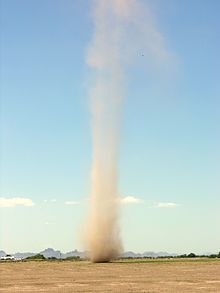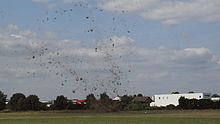Dust devil
A small tornado is a small-scale air vortex with a vertical axis and usually low altitude, which is limited to the atmospheric boundary layer. In contrast to large tornadoes, there is no direct connection with convective cloud cover.
Depending on their appearance and the material stirred up, various names are in use: today's devil, Al Hul (for Bedouins), fog devil, dust devil, sand devil, fire devil, dust trombe, sand trombe, dust trousers and sand trousers. The last two terms are misleading, however, as they can be confused with wind and waterspouts, which are large-scale thunderstorms. Rarely, snow devils also occur. Gustnados (gust front vortices), on the other hand, should not be confused with dust devils.
The condition for the formation of small currents is an overheating of the atmosphere near the ground. In this dry-labile stratification, thermal bubbles detach from the ground, which can concentrate an existing weak rotation of the air by stretching the vortex during rapid ascent. Due to the conservation of angular momentum, the wind speed increases rapidly as a result of the pirouette effect and can reach hurricane force in extreme cases.
An example of a violent dust devil is available from the USA. On 14 September 2000, a sand trombe swept over the Coconino County Fairgrounds in Arizona with estimated wind peaks of 120 km/h. Several people were slightly injured. Several people were slightly injured, and buildings in the path of the vortex suffered minor damage such as covered tarpaulins, torn-off roof tiles, and bent metal rods.
In the course of sand trombets, wind peaks of just over 150 km/h have been measured, and a maximum of 200 km/h seems possible according to the current state of science. In total, however, most small trombets are quite weak and rarely cause damage. In an average dust devil, wind peaks of only around 50 km/h are reached.
The extent of a sand trombe varies greatly - from 0.5 m in diameter to around 200 metres wide and several hundred metres high, all orders of magnitude are possible. Occasionally, dust devils also occur in associations or groups, for example at a squall line.
The lifetime of a small drum ranges from a few seconds to about half an hour. They can remain almost stationary or move forward at walking pace, or in extreme cases at up to 100 km/h.
The direction of rotation of dust devils is not determined by the Coriolis force due to the small spatial extent of the wind; wind direction and orography play a role here. Small dust devils occur most frequently where dry-labile conditions are achieved by strong solar radiation, so especially in desert areas. In mid-latitudes, they are most likely to be found in the warm season over open land areas (uncultivated fields, mown meadows, sports fields, wasteland, sloping areas above the tree line). The special form of gustnado is triggered dynamically on gust fronts before showers or thunderstorms. A rare variant at low air temperatures can be observed over (relatively) warm water surfaces as a fog devil.
Dust devils are not only found on Earth, but have also been observed on Mars.

A dust devil in Arizona, 2003

Todayufel at the airfield Bruchsal in July 2013
.ogv.jpg)
Play media file Video recording: A dust devil emerges and grows (Mexico)
Search within the encyclopedia